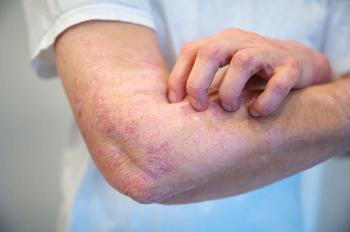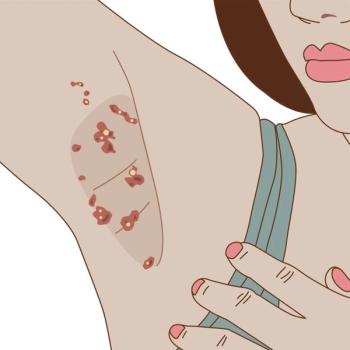
Cutaneous Signs of Vascular Disorders: Polycythemia Vera
Four months after a patchy, macular,erythematous spot erupted on thedorsum of a 63-year-old woman’s leftfoot, the area became ulcerated,tender, and painful. The 1.2-cm ulcerwas covered by a hemorrhagic crustsurrounded by a cyanotic reticulardiscoloration of the skin.
Four months after a patchy, macular,erythematous spot erupted on thedorsum of a 63-year-old woman's leftfoot, the area became ulcerated,tender, and painful. The 1.2-cm ulcerwas covered by a hemorrhagic crustsurrounded by a cyanotic reticulardiscoloration of the skin.The patient's white blood cellcount was 15,500/μL; red bloodcells, 7.7 million/μL; hemoglobin,18.5 g/dL; hematocrit, 59.9%; andplatelet count, 845,000/μL. Her distalpedal pulses were strong. A biopsyof tissue from the affected area revealedsuperficial thrombophlebitis.Polycythemia vera, characterizedby an abnormal proliferation of bonemarrow elements--erythrocytes,leukocytes, and platelets--was diagnosed.This disorder is also markedby increased red cell mass and totalblood volume. The cause is unknown.Some patients with polycythemiavera are asymptomatic; others mayexhibit a range of symptoms, includinga ruddy complexion, pruritus,weakness, headache or light-headedness,visual disturbances, and dyspnea.Petechiae, ecchymoses, arterialthrombosis, thrombophlebitis, legulcers, and livedo reticularis are alsoseen.After the patient underwentphlebotomy for several months, herleg ulcer healed.Alkylating agents and interferonalso may be used to treat polycythemiavera. Treatment of this disordercan reduce the incidence of superficialthrombophlebitis.
Newsletter
Enhance your clinical practice with the Patient Care newsletter, offering the latest evidence-based guidelines, diagnostic insights, and treatment strategies for primary care physicians.

















































































































































































































































































